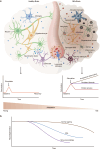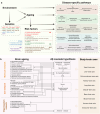Antiageing strategy for neurodegenerative diseases: from mechanisms to clinical advances
- PMID: 40059211
- PMCID: PMC11891338
- DOI: 10.1038/s41392-025-02145-7
Antiageing strategy for neurodegenerative diseases: from mechanisms to clinical advances
Abstract
In the context of global ageing, the prevalence of neurodegenerative diseases and dementia, such as Alzheimer's disease (AD), is increasing. However, the current symptomatic and disease-modifying therapies have achieved limited benefits for neurodegenerative diseases in clinical settings. Halting the progress of neurodegeneration and cognitive decline or even improving impaired cognition and function are the clinically meaningful goals of treatments for neurodegenerative diseases. Ageing is the primary risk factor for neurodegenerative diseases and their associated comorbidities, such as vascular pathologies, in elderly individuals. Thus, we aim to elucidate the role of ageing in neurodegenerative diseases from the perspective of a complex system, in which the brain is the core and peripheral organs and tissues form a holistic network to support brain functions. During ageing, the progressive deterioration of the structure and function of the entire body hampers its active and adaptive responses to various stimuli, thereby rendering individuals more vulnerable to neurodegenerative diseases. Consequently, we propose that the prevention and treatment of neurodegenerative diseases should be grounded in holistic antiageing and rejuvenation means complemented by interventions targeting disease-specific pathogenic events. This integrated approach is a promising strategy to effectively prevent, pause or slow down the progression of neurodegenerative diseases.
© 2025. The Author(s).
Conflict of interest statement
Competing interests: The authors declare no competing interests.
Figures







References
-
- Gauthier, S. Rosa-Neto, P. Morais, J. A. & Webster, C. World Alzheimer Report 2021: Journey through the diagnosis of dementia. Alzheimer's Disease International. https://www.alzint.org/resource/world-alzheimer-report-2021/ (2021).
-
- Garre-Olmo, J. Epidemiology of Alzheimer’s disease and other dementias. Rev. Neurol.66, 377–386 (2018). - PubMed
Publication types
MeSH terms
LinkOut - more resources
Full Text Sources
Medical

